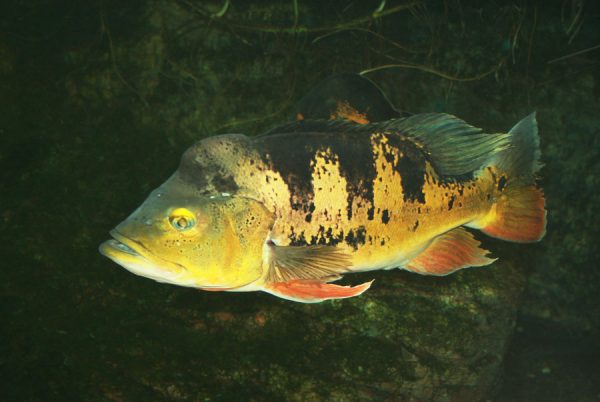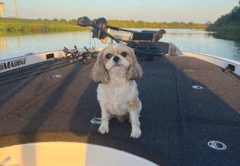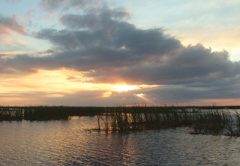The Butterfly Peacock, also known as Peacock Bass, is an extremely popular freshwater non-native fish introduced to south Florida in 1984 by the Florida Fish and Wildlife Conservation Commission (FWC). Known as a strong fighting fish, the Peacock Bass, a member of the Cichlid Family and a native of the Amazon basin in South America was introduced into the waterways of south Florida as a sport fish and to control the growing non-native Cichlid and African Spotted Tilapia population.
The Butterfly Peacock has a bass-like shaped body with a large protruding lower jaw. They are very colorful with a green to black dorsal surface with yellow to cream colored sides. They have three thick black vertical bars down the sides and they have a large black spot with a white or yellow-gold halo on the caudal tail. Adult males can be distinguished from females for they have a pronounced hump forward of the dorsal fin. Due to their sensitivity to temperatures below 60°F, they are generally restricted to the deep water canals of Palm Beach, Broward and Miami-Dade Counties. The average weight of a Butterfly Peacock in a fish in the 1-2 lb class. The Florida State Record stands at 9.08 lbs though a 12 pound fish measuring 25.5 inches was caught but never reported to the state. The IGFA World Record is a 12.6 lb fish caught in Venezuela. The State regulation for the harvesting of Butterfly Peacock Bass is two fish per day of which only one may be 17-inches or longer in total length. The Peacock Bass is also a species in the FWC Big Catch Angler Recognition Program with minimum entry being 18-inches or 4-lbs for adults and 13-inches or 3 lbs for youth under the age of 16.
Fishing for Peacock Bass is similar to fishing for largemouth bass with the exception of plastic worms. Baits such as small Rapala-like stick baits, spinners, Pop-Rs, Tiny Torpedoes, and even jigs will catch Peacock Bass. Just leave the plastic worms home or for the largemouth bass. However like largemouth bass, live shiners around 3-inches long are Peacock’s preferred prey. Since most of the canals have limited vegetation cover, you can downsize your rod and reel to lightweight spinning or bait-casting equipment. Fly-fishermen will also find this an exceptional species to target. Peacocks are hard strikers and they provide strong runs with plenty of acrobatics.
You’ll find Peacock Bass just about anywhere you find largemouth bass. Shaded areas provided by bridges and overhanging trees, culverts and other water structures, fallen trees and submerged logs, canal ends and intersections, and along shoreline vegetation are all good starting points for finding these fish. Peacocks are generally caught during daylight hours so you can save your nights for other quarry.
The Butterfly Peacock Bass provides great table fare. Its flesh is white meat with very little oil and produce nice size fillets. When cooked the meat is flaky and tender with a light sweet taste similar to snapper. They take seasoning well and just about any type of cooking technique from frying, grilling, baking, and stir-fry.
Whether you are a local resident or short term visitor, whether you are a saltwater fishermen or a freshwater fishermen, spending some time fishing for Butterfly Peacock Bass will be time well spent.







